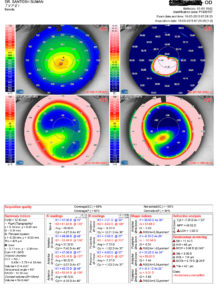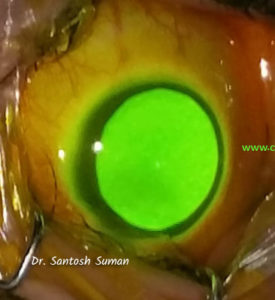1. What is Keratoconus?
Keratoconus is the condition of the cornea, in which the cornea assumes a conical shape.

2. Is Keratoconus present from birth?
No, it usually manifests at the age of puberty and usually tends to progress (worsen) till the age of 30-35 years.
3. How do I suspect that I may have keratoconus?
If a patient has frequent change of glasses, he/she must be evaluated for keratoconus.
4. What are the tests to diagnose Keratoconus?
Ophthalmologists/ optometrists usually suspect keratoconus when abnormal ‘Scissoring reflex’ is seen on retinoscopy. Confirmation of keratoconus can be done by the topography of the cornea. Advanced stages of keratoconus can be diagnosed on the slit lamp itself. Also, there are Pachymeteres which can measure the thickness of the cornea at various zones of the cornea.

5. Are all Keratoconus cases progressive?
Keratoconus usually starts at the age of puberty and progresses till 30-35 years of age. If detected earlier, keratoconus usually has greater chance of progression. Nearing the age of 30 years, chance of progression is usually lesser.
6. What is “rupture of cornea” in keratoconus ?
In a small percentage of advanced keratoconus cases, the inner layer of the cornea gives way and fluid accumulates in the layers of the cornea. This condition is known as “Acute Hydrops”.

7. What is the Corneal Collagen Cross Linking (C3R/ CXL) ?
The cornea is largely composed of fibers which are called collagen. The collagen is interlinked with one other to give strength to the cornea and allow it to retain its shape. In Keratoconus, the cross-linking between groups of collagen fibers is reduced, causing the cornea to stretch forward in response to the normal pressure from within the eye, thus worsening the cone. C3R procedure causes cross-linking among these collagen fibers and provides strength to the cornea.
8. How Is C3R procedure done?
Topical anesthesia is applied. The outermost layer of the cornea is scraped off. Then riboflavin drops are instilled onto the cornea surface for 30 minutes. Then the ultraviolet rays are focused onto the cornea, using a special UV lamp for 10 to 30 minutes. The eye can be bandaged or a bandage contact lens is applied at the end of the procedure.
However, for the safety of this procedure, the corneal thickness has to be a minimum of 400 microns, to prevent UV damage to the innermost layer of the cornea (endothelium). Hence it cannot be done in advanced keratoconus, where the cornea is already considerably thinned out.
Some modifications in C3R are there for advanced keratoconus where the very thin cornea is swelled up (using hypotonic riboflavin/ saline drops) before C3R to prevent damage to the endothelium.

9. What are the special contact lenses for Keratoconus ?
There are various options. Let your doctor decide which is best for you.
There are hard contact lenses. The other lenses are RGP (rigid-gas permeable) or ‘semi-soft’ contact lenses, which allow oxygen to enter the cornea through the lens. These are larger in size. Another option is ‘piggy-back’ lense, i.e. a soft contact lens, which is large and sits snugly over the conical cornea and is comfortable, over which you wear a hard or RGP lens, to improve vision.
There are special large lenses designed for Keratoconus, called “Rose K2 lenses”.The last option is the Scleral Lens, which is very expensive.
10. What is DALK surgery in advance keratoconus?
If a patient has very advance keratoconus or has corneal scar involving central cornea or patient is not able to wear contact lenses, such patients need corneal transplant. DALK is a type of corneal transplant, where only the outer layers are replaced by donor cornea. Innermost layer (Descemet’s membrane and Endothelium) remains intact. DALK has much lesser chance of rejection, compared to PK (Penetrating keratoplasty, where all the layers of cornea is replaced).
